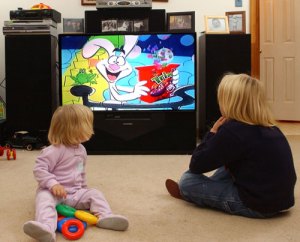
I’m a little older than the desired demographic, but as an early childhood educator, I was fascinated by the cable station, Baby First TV was first launched (230 on Rogers Cable). Is it a good idea to encourage babies and toddlers to watch television?
Some programming delights: I watched babies and parents playing with stuffed-toy dogs as they listened to “Oh, Where, Oh Where, Has My Little Dog Gone?” Karaoke-style lyrics show on the TV screen as first a woman and then a man sing the lyrics. Parents will surely scrounge up a toy dog to join in this hide-and-seek game.
Some programming mimics real-life activities: A voice tells how to place the animal pieces into a 3-D wooden puzzle. Toddlers who watch will doubtless learn more quickly how to complete puzzles like this. And the quiet, steady voice encourages a powerful reflective learning style. In “Peek-a-Boo, I See You!” an appealing creature hides and reappears from behind a bureau. Parent viewers are reminded how much babies like this game. Babies can even watch a kaleidoscope on the TV; the colours and motion are sure to capture their attention. So will a simple segment showing a mobile going round—from the perspective of an infant lying in a crib—and another just displaying a babbling brook.
Some of the programming is simply puzzling: An animated boy without a violin body visits a house where a maestro with a face like a music stand displaying an open score gives him a violin front that becomes the trunk of his body. Talking animals made of fruits and vegetables tunnel through the Earth and walk upside-down when they reach the other side. I’m not sure why adults so often seem to think children will find this anti-science more fascinating than real life, say the birth of a colt or the growth of a rainstorm.
Is it good or bad for babies and toddlers to watch such TV? I worry that infants might hurt their vision development if they watch for a long time: Is it good for them to gaze for a long time at just one focal length? And the incessant music—so much of it sounding like a music box—may cause infants to just ignore it. It’s almost like the creators are afraid of natural sounds. Surely kids would enjoy hearing the water coursing about the stones of the video of the brook! Kids do learn from observation: A child who’s looked at Thomas the Tank Engine may be startled by the size of a real train, but she already knows something about them. I wish the channel showed more segments of gardeners, bricklayers, bakers, bus drivers, grocery store clerks—with natural sounds. To encourage an appreciation of music, why not show more video of real musicians making music? Lucky infants will live with parents who occasionally watch Baby First TV with them and just chat about the curious things they see. Really, how different is that from looking at a picture book together? The station should also close-caption all the shows: Deaf and hard-of-hearing parents are watching, too! And spend the money to properly capitalize and punctuate the captions. Displaying captions will even help some viewers learn to read.

